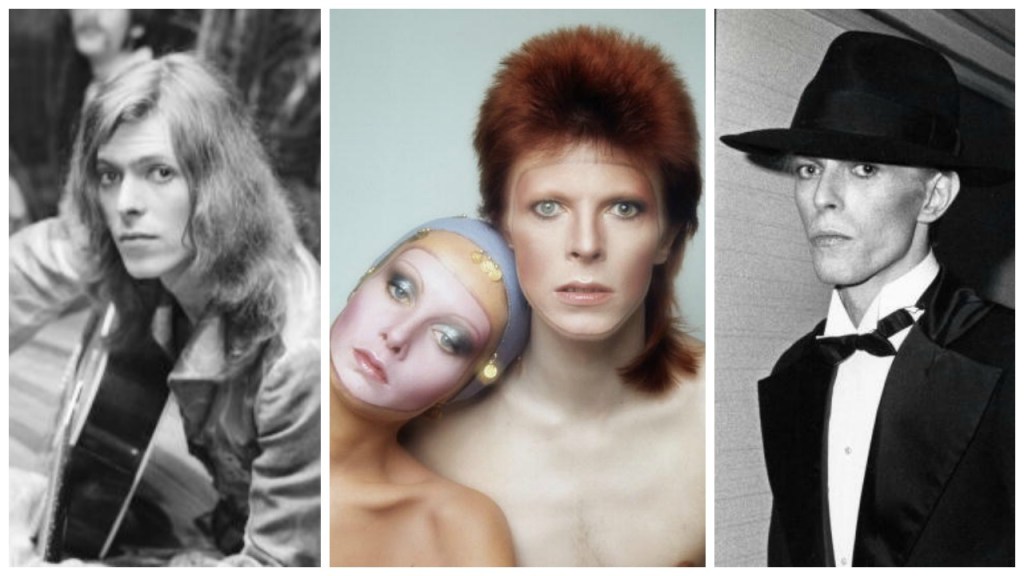The world mourns today after David Bowie, one of the most defining and iconic figures of the last century, passed away yesterday following an 18-month battle with cancer.
A huge blow to music fans the world over, Bowie’s impact on not just music but culture in general cannot be overstated. A savant when it came to pairing image, character and music to create a cultural entity of himself greater than the sum of his influences, it was Bowie’s ability to craft a mythology around himself while backing it up with timeless music which truly set him apart from his contemporaries.
With a career that spanned over half a century, Bowie not only gave us many great songs — he gave us so many amazing versions of himself over the years, that we thought we’d look back his legacy through his many eras from Space Oddity to his latest and final album, Blackstar.
Pre-Ziggy: Space Oddity, Hunky Dory and The Man Who Sold The World
David Bowie – Space Oddity
Famously inspired by Stanley Kubrick’s 2001: A Space Odyssey, Space Oddity, the title track from Bowie’s 1969 sophomore album, is a true slice of pop genius, not least because it pioneered syncronised marketing by being released five days before the Apollo 11 moon landing.
Later re-recorded and re-released with a more Ziggy Stardust-flavored video, the original clip above is an amazing look at Bowie pre-stardom, Space Oddity being the single that would establish him as a solo artist.
Outer-space Pop Idol: Ziggy Stardust and The Spiders From Mars and Aladdin Sane
David Bowie – Starman
It would be the time Bowie spent in the US promoting his third album The Man Who Sold The World (1970) that would inspire him to create his greatest creation to date, the outer-space pop idol Ziggy Stardust. A melding of the image and character of Iggy Pop with the music of Lou Reed, The Rise and Fall of Ziggy Stardust and The Spiders from Mars would come to be one of the most seminal albums of the 20th Century.
The album was so successful it actually dragged his previous work, fourth album Hunk Dory (which was six months old at the time) back into the charts along with other previously released tracks. Bowie would keep up the same aesthetic for the next album Aladdin Sane, before famously retiring the character of Ziggy onstage in 1973.
The Thin White Duke: Young Americans and Station To Station
David Bowie – Fame
While he did try to leave Ziggy behind in 1973, Bowie’s next album Diamond Dogs (1974) still very much bore the mark of the martian pop idol. However, with 1975’s Young Americans, recorded in Philadelphia while on tour in 1974, Bowie would drastically change his aesthetic and sound, embracing funk and soul in a style he called ‘plastic soul’.
Along with his subsequent album Station To Station (1976), this period saw Bowie release legendary singles like Fame and Golden Years. This era would also introduce us to Bowie’s new character — The Thin White Duke.
Powered largely by cocaine during this period, Bowie’s new character was almost a physical embodiment of the drug. Stylish, aloof, pale and skinny, it was as the duke that Bowie would make history by being the first white artist to perform on Soul Train. His embracing of African American music on these albums was a huge milestone in such music reaching the mainstream.
Personal Lows and Creative Highs: Low, Heroes and Lodger
David Bowie – Heroes
https://youtu.be/Tgcc5V9Hu3g
Leading up to what many would later see as his creative peak, in the late ’70s Bowie’s physical and mental well-being were being tested by a mixture of litigation between him and his management as well as his own addiction, the singer reportedly surviving on a diet of cocaine and milk during this period. Bowie’s solution was to move to Berlin to escape his addiction, as well as to look for inspiration in the burgeoning Berlin krautrock scene.
Teaming up with Brian Eno and Tony Visconti, Bowie would release two albums in 1977, Low and Heroes, both of which would be held up for years after as examples of the true potential of pop music. Enlisting the likes of Robert Fripp on guitar and employing a lot of ambient sounds from synthesizers and other non-traditional instruments, these two albums would give way to 1979’s Lodger, where Bowie would begin to bring together his krautrock, pop and rock influences, prefiguring what would become his most successful period.
Return To Pop: Scary Monsters (and Super Creeps) and Let’s Dance
David Bowie – Ashes To Ashes
Having spent the better part of the ’70s at the bottom of a bag or a bottle, at the dawn of the ’80s Bowie was about to take over the world, although he hardly knew it. Abandoning the image of the Thin White Duke, he embraced the style and sounds of the decade with wild abandon.
The album Scary Monsters (and Super Creeps) saw Bowie revisit the character of Major Tom from Space Oddity with the huge hit Ashes To Ashes. The music video for the song going down as a defining early example of the artform, it’s bizarre colorization, horribly dated 80’s video effects and appropriation of New Romantic aesthetics going on to influence hordes of musicians and directors.
David Bowie – Let’s Dance
It would be Bowie’s next album, 1983’s Let’s Dance, that would really see him achieve complete world domination. The Nile Rodgers co-produced album went platinum in the UK and US, and its title track reached No. 1 in both markets.
Bowie would also push the envelope with the videos for this album. The video for Let’s Dance holds a particular point of affection for us Aussies for being partly set in Australia (seriously if you haven’t seen it watch the video above if only for the shots of Bowie dressed up in full 80’s gear playing guitar in a outback pub while a lone Aboriginal girl dances by the bar. Only in the ’80s).
The Later Years: Tin Machine, Black Tie White Noise, Earthling and Reality
David Bowie – They Say Jump
https://youtu.be/hZSWZLJeIzI
Struggling throughout the end of the ’80s with the pressure to live up to the success of Let’s Dance, Bowie would strike out in a series of bold directions at the end of the decade, even momentarily abandoning his solo career to start the short-lived four-piece, Tin Machine in 1989 (the less said about this the better).
He would experiment with hip hop, soul and jazz on 1993’s Black Tie White Noise and it’s lead single Jump They Say. 1997’s Earthling saw him take on drum’n’bass and jungle to critical acclaim. Lead single I’m Afraid Of Americans was remixed by Nine Inch Nails’ Trent Reznor for a single release, going on to spend 16 weeks in the Billboard Hot 100 aided somewhat by the Bowie and Reznor-staring video that was put on high rotation on MTV.
David Bowie – I’m Afraid Of Americans
Bowie released Reality in 2003, and the subsequent A Reality Tour went on to be the most profitable of 2004. Health problems began to best him, though, and he had to cut the tour short to recuperate from an angioplasty to treat an acutely blocked coronary artery.
Retreating from the spotlight and even the studio, the next ten years would only see Bowie make sporadic public appearances and guest spots with various artists, like on TV On The Radio’s Providence.
Last Days and Final Works: Where Are We Now, The Stars (Are Out Tonight) and Blackstar
Out of nowhere in 2013, Bowie re-emerged from obscurity with a new album, The Next Day, and a series of eerie singles and videos. Where Are We Now?, a sociopolitical meditation with its own lyric video, was first to drop. The Stars (Are Out Tonight) was soon to follow, landing with a bizarre short film/music video starring Tilda Swinton and Bowie as an elderly couple.
David Bowie – The Stars (Are Out Tonight)
This then led to Blackstar, his final album and his self-penned requiem.
“He always did what he wanted to do. And he wanted to do it his way and he wanted to do it the best way,” said producer Tony Visconti of the album following Bowie’s death. “His death was no different from his life – a work of Art. He made Blackstar for us, his parting gift.”
David Bowie – Lazarus
Liberated to finally follow his longtime idol Scott Walker down the rabbit whole of dark twisted fantastical avant garde compositions, Bowie does away with the trappings of pop music on Blackstar, the album serving as a window into how he dealt with his impending death.
With such sombre subject matter, Bowie embraced the darkest visual aesthetic of his career on the album, the videos for its singles Blackstar and Lazarus featuring dark, gothic and paranoid imagery which mirrors the ghostly beauty of the music.
David Bowie – Blackstar
It’s fitting that a man who always tried to follow his own creative impulse and never be led by others should leave us with such a singular work of art as a parting gift. It speaks to his love of music and his fans that he would dedicate so many of his final days to working on this, his gift to us.
And while many of us are surely heartbroken, obsessively listening back to all his music that meant so much to us over the years, it’s his lyrics from Blackstar that keep running around in my head:
“Something happened on the day he died.
Spirit rose a metre and stepped aside.
Somebody else took his place, and bravely cried.
(I’m a blackstar, I’m a blackstar).”
It seems even in death, he aimed to inspire others. May he rest in peace.
Gallery: 25 Iconic Photos of David Bowie
30 Iconic Bowie Photos
-
David Bowie (1947 - 2016)
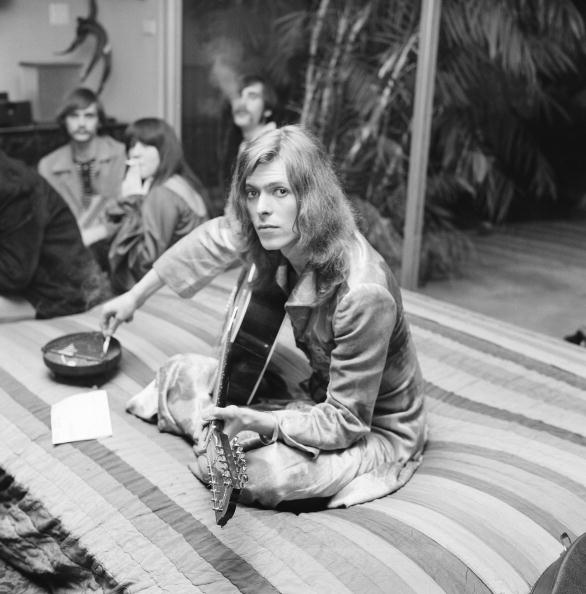
LOS ANGELES - JANUARY 1971: A pre-glam David Bowie jams at a party thrown by publicist and future nightclub impresario and DJ Rodney Bingenheimer at lawyer Paul Figen's house in January 1971, in Los Angeles, California. (Photo by Earl Leaf/Michael Ochs Archives/Getty Images) -
David Bowie (1947 - 2016)

Singer David Bowie being interviewed at home in Beckenham, London on April 24, 1972. (Photo by Michael Putland/Getty Images) -
David Bowie (1947 - 2016)
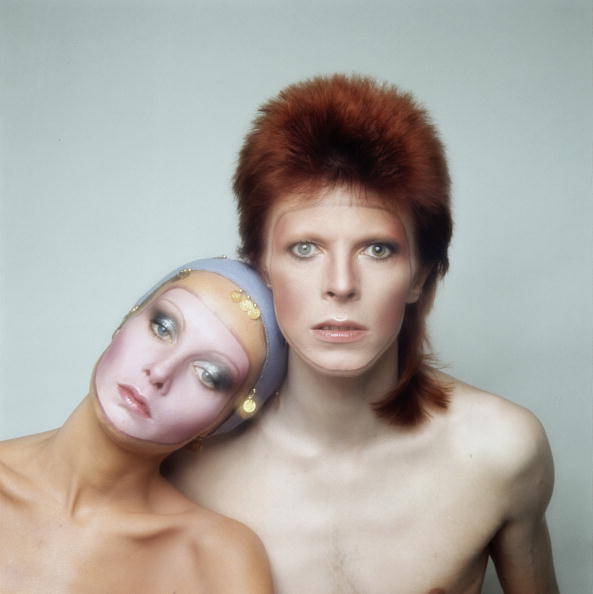
English model Twiggy poses with David Bowie in Paris for the cover of his 'Pin Ups' album, 1973. (Photo by Justin de Villeneuve/Hulton Archive/Getty Images) -
David Bowie (1947 - 2016)
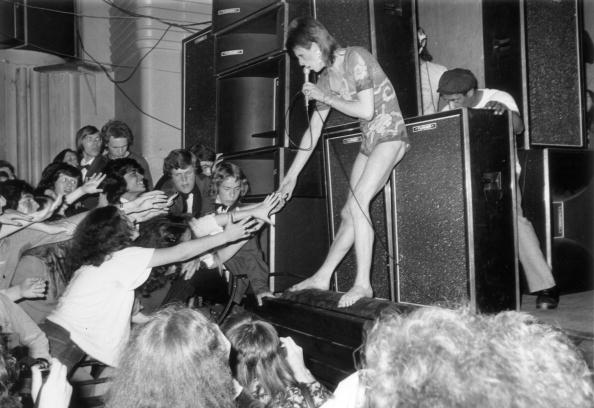
3rd July 1973: Adoring fans reaching out to touch the hand of the English pop star, David Bowie, during the concert at the Hammersmith Odeon where Bowie announced that he was retiring his alter-ego 'Ziggy Stardust'. (Photo by Steve Wood/Express/Getty Images) -
David Bowie (1947 - 2016)

Angie Bowie, Zowie Bowie (Duncan Jones) and David Bowie (wearing an eyepatch) appear at a press conference at the Amstel Hotel on 7th February 1974 in Amsterdam, Netherlands. (Photo by Gijsbert Hanekroot/Redferns) -
David Bowie (1947 - 2016)
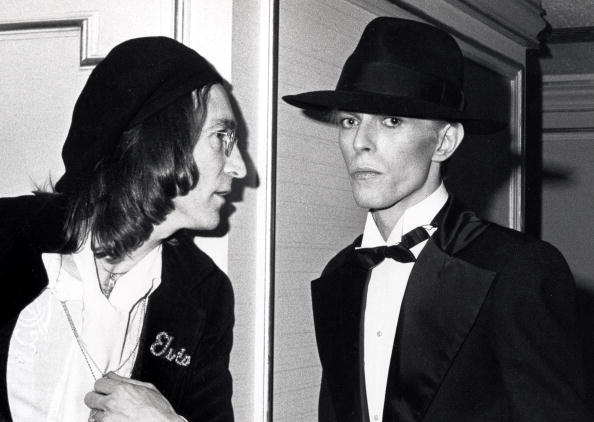
John Lennon and David Bowie during The 17th Annual GRAMMY Awards at Uris Theater in New York City, New York, United States. (Photo by Ron Galella/WireImage) -
David Bowie (1947 - 2016)
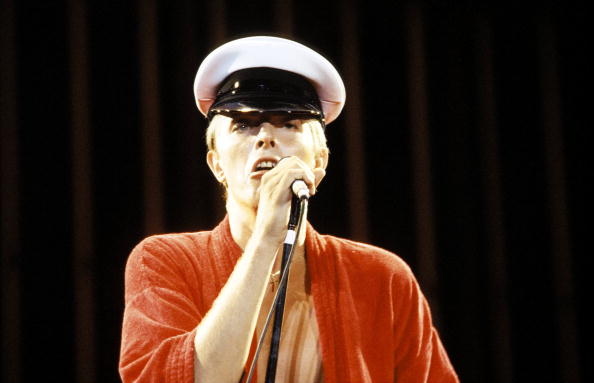
AUSTRALIA - NOVEMBER 24: Photo of David BOWIE; performing live onstage on the Low/Heroes 1978 World Tour at R.A.S. Showgrounds (Photo by Bob King/Redferns) -
David Bowie (1947 - 2016)
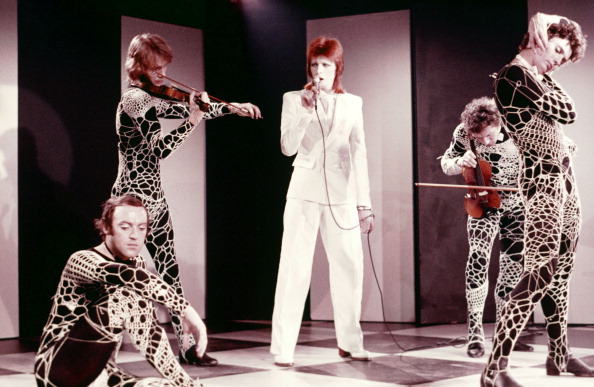
MIDNIGHT SPECIAL -- "The 1980 Floor Show staring David Bowie" Episode 210 -- Aired: 11/16/73 -- Pictured: David Bowie with the Astronettes during his last show as Ziggy Stardust filmed mostly at The Marquee Club in London, England from October 18-20, 1973 -- (Photo by: NBC/NBCU Photo Bank via Getty Images) -
David Bowie (1947 - 2016)
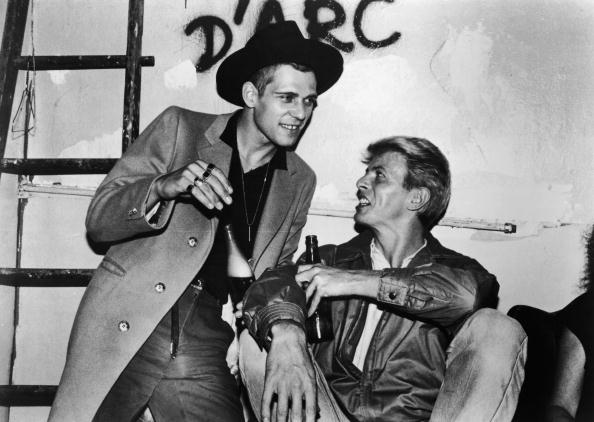
British rock singer and actor David Bowie (R) has a drink backstage with Paul Simonon, the bassist from British punk rock band The Clash, following the group's concert at Shea Stadium, Queens, New York City, circa 1982. (Photo by Hulton Archive/Getty Images) -
David Bowie (1947 - 2016)
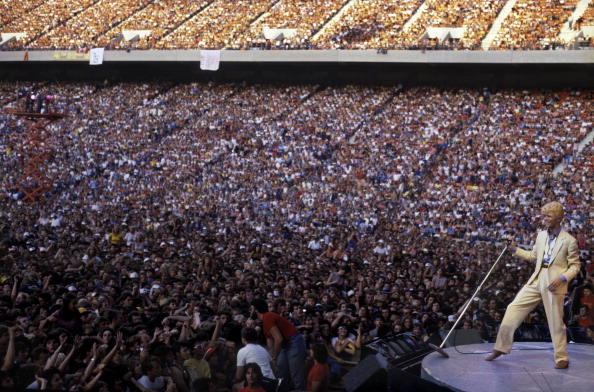
David Bowie performing on stage in Winnipeg, 1983. (Photo by Denis O'Regan/Getty Images) -
David Bowie (1947 - 2016)
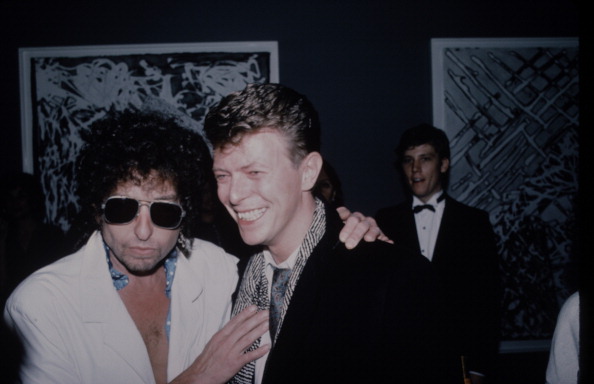
UNITED STATES: Singer and musician David Bowie with Bob Dylan (left), circa 1985. (Photo by The LIFE Picture Collection/Getty Images) -
David Bowie (1947 - 2016)
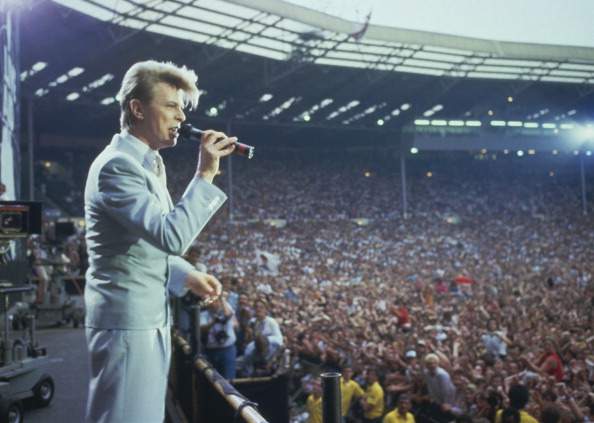
English singer David Bowie performing at the Live Aid concert at Wembley Stadium in London, 13th July 1985. The concert raised funds for famine relief in Ethiopia. (Photo by Georges De Keerle/Getty Images) -
David Bowie (1947 - 2016)
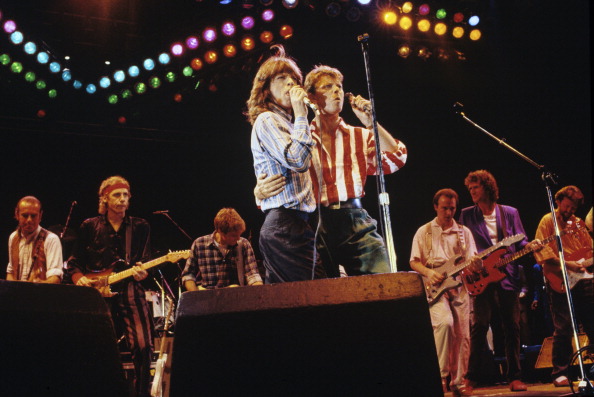
LONDON - JUNE 20: Mick Jagger and David Bowie performing on stage at The Prince's Trust 10th Birthday Party at Wembley Arena, London, United Kingdom on 20th June 1986. Behind them from left to right are: Francis Rossi, Mark Knopfler, Bryan Adams, Midge Ure, John Illsley, Eric Clapton. (Photo by Brian Cooke/Redferns) -
David Bowie (1947 - 2016)

Actors David Bowie and Jennifer Connelly in a scene from the movie 'Labyrinth', 1986. (Photo by Stanley Bielecki Movie Collection/Getty Images) -
David Bowie (1947 - 2016)
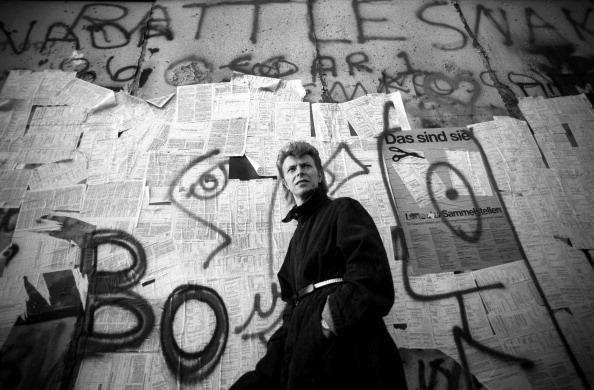
David Bowie at the Berlin Wall, 1987. (Photo by Denis O'Regan/Getty Images) -
David Bowie (1947 - 2016)
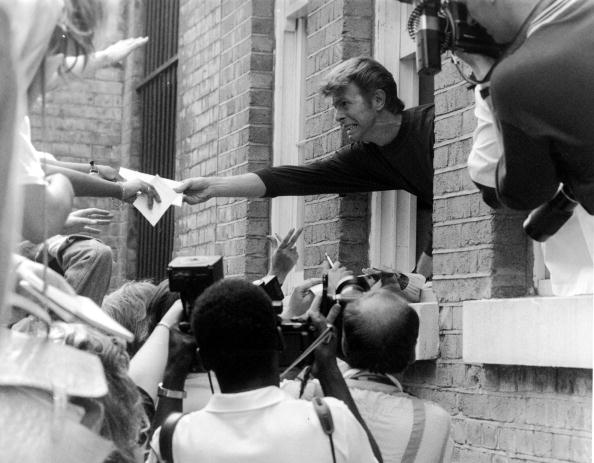
English singer David Bowie leans out of a window to pass autographs to fans during a visit to, Brixton, London, 6th July 1989. Bowie is visiting his birthplace for the opening of the new Brixton community centre, which he helped fund. (Photo by Dave Hogan/Getty Images) -
David Bowie (1947 - 2016)
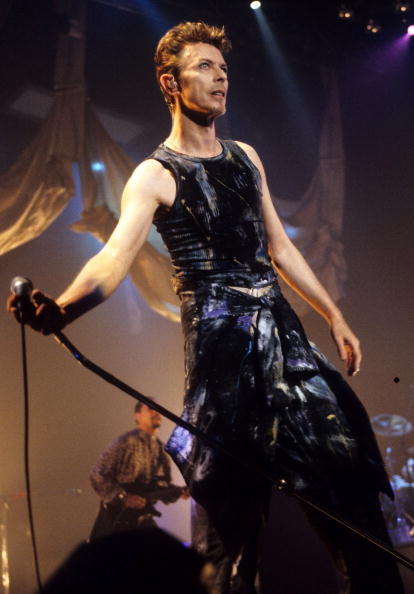
David Bowie performing with Nine Inch Nails 1995 (Photo by Ke.Mazur/WireImage) -
David Bowie (1947 - 2016)
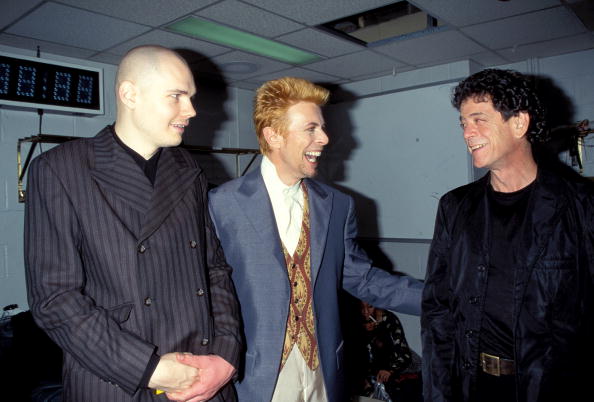
Billy Corgan, David Bowie and Lou Reed (Photo by KMazur/WireImage) -
David Bowie (1947 - 2016)

David Bowie during David Bowie's 50th Birthday Celebration Concert at Madison Square Garden in New York City, New York, United States. (Photo by Patti Ouderkirk/WireImage) -
David Bowie (1947 - 2016)

Dave Grohl and David Bowie during David Bowie's 50th Birthday Celebration Concert at Madison Square Garden in New York City, New York, United States. (Photo by KMazur/WireImage) -
David Bowie (1947 - 2016)

English singer David Bowie with American rapper Diddy (Sean Combs) in a recording studio, circa 2001. (Photo by Dave Hogan/Getty Images) -
David Bowie (1947 - 2016)

David Bowie during David Bowie "Reality Tour" at Madison Square Garden - Show at Madison Square Garden in New York City, New York, United States. (Photo by KMazur/WireImage) -
David Bowie (1947 - 2016)

NEWPORT, ENGLAND - JUNE 13: David Bowie performs on stage on the third and final day of "The Nokia Isle of Wight Festival 2004" at Seaclose Park, on June 13, 2004 in Newport, UK. The third annual rock festival takes place during the Isle of Wight Festival which runs from June 4-19. (Photo by Jo Hale/Getty Images) -
David Bowie (1947 - 2016)
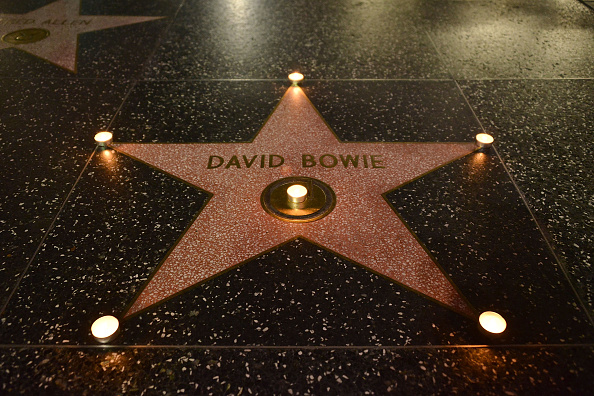
HOLLYWOOD, CA - JANUARY 10: David Bowie remembered on The Hollywood Walk of Fame on January 10, 2016 in Hollywood, California. (Photo by Araya Diaz/Getty Images) -
David Bowie (1947 - 2016)
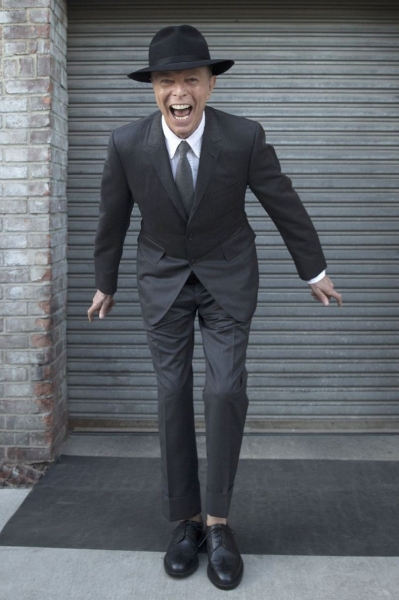
The last picture of David Bowie taken by his wife Iman last Friday on his 69th birthday.
